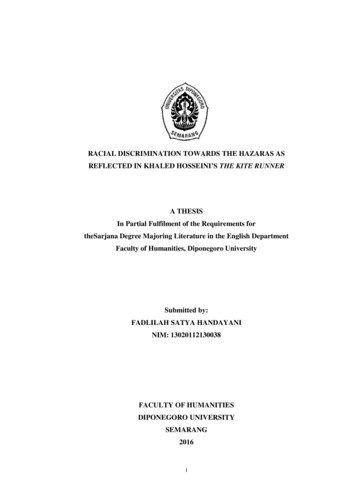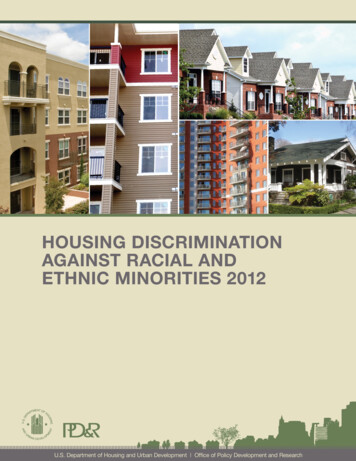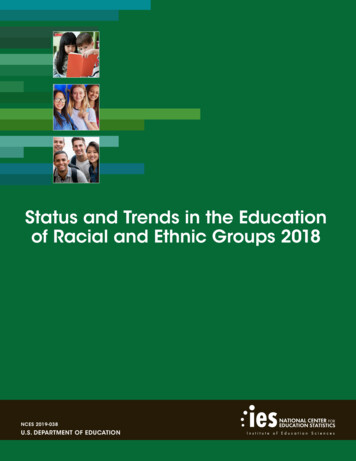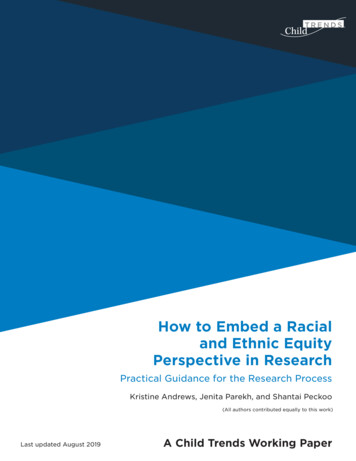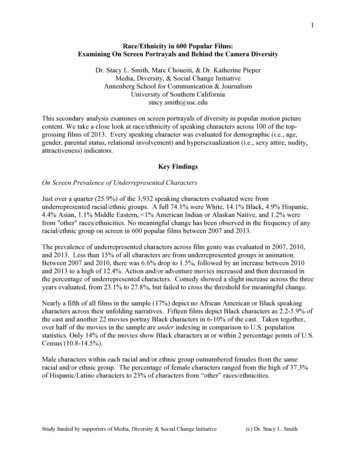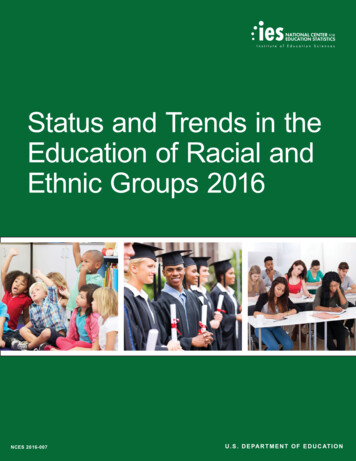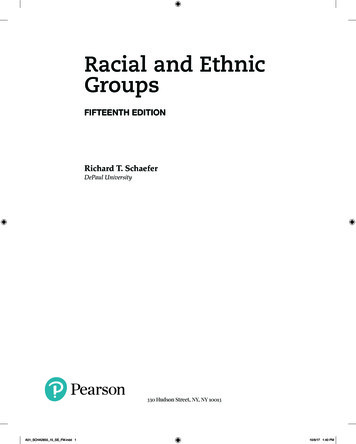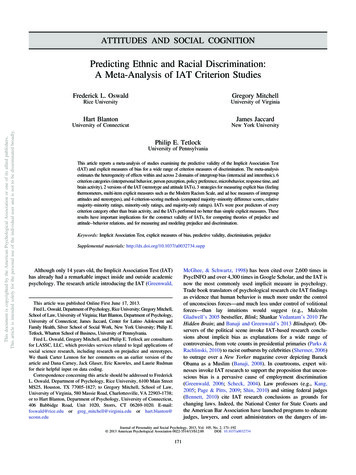
Transcription
ATTITUDES AND SOCIAL COGNITIONThis document is copyrighted by the American Psychological Association or one of its allied publishers.This article is intended solely for the personal use of the individual user and is not to be disseminated broadly.Predicting Ethnic and Racial Discrimination:A Meta-Analysis of IAT Criterion StudiesFrederick L. OswaldGregory MitchellRice UniversityUniversity of VirginiaHart BlantonJames JaccardUniversity of ConnecticutNew York UniversityPhilip E. TetlockUniversity of PennsylvaniaThis article reports a meta-analysis of studies examining the predictive validity of the Implicit Association Test(IAT) and explicit measures of bias for a wide range of criterion measures of discrimination. The meta-analysisestimates the heterogeneity of effects within and across 2 domains of intergroup bias (interracial and interethnic), 6criterion categories (interpersonal behavior, person perception, policy preference, microbehavior, response time, andbrain activity), 2 versions of the IAT (stereotype and attitude IATs), 3 strategies for measuring explicit bias (feelingthermometers, multi-item explicit measures such as the Modern Racism Scale, and ad hoc measures of intergroupattitudes and stereotypes), and 4 criterion-scoring methods (computed majority–minority difference scores, relativemajority–minority ratings, minority-only ratings, and majority-only ratings). IATs were poor predictors of everycriterion category other than brain activity, and the IATs performed no better than simple explicit measures. Theseresults have important implications for the construct validity of IATs, for competing theories of prejudice andattitude–behavior relations, and for measuring and modeling prejudice and discrimination.Keywords: Implicit Association Test, explicit measures of bias, predictive validity, discrimination, prejudiceSupplemental materials: http://dx.doi.org/10.1037/a0032734.suppAlthough only 14 years old, the Implicit Association Test (IAT)has already had a remarkable impact inside and outside academicpsychology. The research article introducing the IAT (Greenwald,McGhee, & Schwartz, 1998) has been cited over 2,600 times inPsycINFO and over 4,300 times in Google Scholar, and the IAT isnow the most commonly used implicit measure in psychology.Trade book translators of psychological research cite IAT findingsas evidence that human behavior is much more under the controlof unconscious forces—and much less under control of volitionalforces—than lay intuitions would suggest (e.g., MalcolmGladwell’s 2005 bestseller, Blink; Shankar Vedantam’s 2010 TheHidden Brain; and Banaji and Greenwald’s 2013 Blindspot). Observers of the political scene invoke IAT-based research conclusions about implicit bias as explanations for a wide range ofcontroversies, from vote counts in presidential primaries (Parks &Rachlinski, 2010) to racist outbursts by celebrities (Shermer, 2006)to outrage over a New Yorker magazine cover depicting BarackObama as a Muslim (Banaji, 2008). In courtrooms, expert witnesses invoke IAT research to support the proposition that unconscious bias is a pervasive cause of employment discrimination(Greenwald, 2006; Scheck, 2004). Law professors (e.g., Kang,2005; Page & Pitts, 2009; Shin, 2010) and sitting federal judges(Bennett, 2010) cite IAT research conclusions as grounds forchanging laws. Indeed, the National Center for State Courts andthe American Bar Association have launched programs to educatejudges, lawyers, and court administrators on the dangers of im-This article was published Online First June 17, 2013.Fred L. Oswald, Department of Psychology, Rice University; Gregory Mitchell,School of Law, University of Virginia; Hart Blanton, Department of Psychology,University of Connecticut; James Jaccard, Center for Latino Adolescent andFamily Health, Silver School of Social Work, New York University; Philip E.Tetlock, Wharton School of Business, University of Pennsylvania.Fred L. Oswald, Gregory Mitchell, and Philip E. Tetlock are consultantsfor LASSC, LLC, which provides services related to legal applications ofsocial science research, including research on prejudice and stereotypes.We thank Carter Lennon for her comments on an earlier version of thearticle and Dana Carney, Jack Glaser, Eric Knowles, and Laurie Rudmanfor their helpful input on data coding.Correspondence concerning this article should be addressed to FrederickL. Oswald, Department of Psychology, Rice University, 6100 Main StreetMS25, Houston, TX 77005-1827; to Gregory Mitchell, School of Law,University of Virginia, 580 Massie Road, Charlottesville, VA 22903-1738;or to Hart Blanton, Department of Psychology, University of Connecticut,406 Babbidge Road, Unit 1020, Storrs, CT 06269-1020. E-mail:foswald@rice.edu or greg mitchell@virginia.edu or hart.blanton@uconn.eduJournal of Personality and Social Psychology, 2013, Vol. 105, No. 2, 171–192 2013 American Psychological Association 0022-3514/13/ 12.00DOI: 10.1037/a0032734171
This document is copyrighted by the American Psychological Association or one of its allied publishers.This article is intended solely for the personal use of the individual user and is not to be disseminated broadly.172OSWALD ET AL.plicit bias in the legal system, and many of the lessons in theseprograms are drawn directly from the IAT literature (Drummond,2011; Irwin & Real, 2010).These applications of IAT research assume that the IAT predictsdiscrimination in real-world settings (Tetlock & Mitchell, 2009).Although only a handful of studies have examined the predictivevalidity of the IAT in field settings (e.g., Agerström & Rooth,2011), many laboratory studies have examined the correlationbetween IAT scores and criterion measures of intergroup discrimination. The earliest IAT criterion studies were predicated onsocial cognitive theories that assign greater influence to implicitattitudes on spontaneous than deliberate responses to stimuli (e.g.,Fazio, 1990; see Dovidio, Kawakami, Smoak, & Gaertner, 2009;Olson & Fazio, 2009). These investigations examined the correlation between IAT scores and the spontaneous, often subtle behaviors exhibited by majority-group members in interactions withminority-group members (e.g., facial expressions and body posture; cf. McConnell & Leibold, 2001; Richeson & Shelton, 2003;Vanman, Saltz, Nathan, & Warren, 2004). Other studies sought togo deeper, using such approaches as fMRI technology to identifythe neurological origins of implicit biases and discrimination (e.g.,Cunningham et al., 2004; Richeson et al., 2003). As the popularityof implicit bias as a putative explanation for societal inequalitiesgrew (e.g., Blasi & Jost, 2006), criterion studies started examiningthe relation of IAT scores to more deliberate conduct, such asjudgments of guilt in hypothetical trials, the treatment of hypothetical medical patients, and voting choices (e.g., Green et al.,2007; Greenwald, Smith, Sriram, Bar-Anan, & Nosek, 2009;Levinson, Cai, & Young, 2010).In 2009, Greenwald, Poehlman, Uhlmann, and Banaji quantitatively synthesized 122 criterion studies across many domains inwhich IAT scores have been used to predict behavior, rangingfrom self-injury and drug use to consumer product preferences andinterpersonal relations. They concluded that, “for socially sensitivetopics, the predictive power of self-report measures was remarkably low and the incremental validity of IAT measures wasrelatively high” (Greenwald, Poehlman, et al., 2009, p. 32). Inparticular, “IAT measures had greater predictive validity than didself-report measures for criterion measures involving interracialbehavior and other intergroup behavior” (Greenwald, Poehlman, etal., 2009, p. 28).The Greenwald, Poehlman, et al. (2009) findings have potentially far-ranging theoretical, methodological, and even policyimplications. First, these results appear to support the constructvalidity of the IAT. Because of controversies surrounding whatexactly the IAT measures, a key test of the IAT’s construct validityis whether it predicts relevant social behaviors (e.g., Arkes &Tetlock, 2004; Karpinski & Hilton, 2001; Rothermund & Wentura,2004), and Greenwald, Poehlman, et al.’s findings suggest that thistest has been passed. Second, Greenwald, Poehlman, et al.’s finding that the IAT predicted criteria across levels of controllabilityweighs against theories that assign implicit constructs greaterinfluence on spontaneous than controlled behavior (e.g., Strack &Deutsch, 2004; see Perugini, Richetin, & Zogmaister, 2010).Third, the finding that the IAT outperformed explicit measures insocially sensitive domains, paired with the finding that both implicit and explicit measures showed incremental validity acrossdomains, supports dual-construct theories of attitudes. It furtherargues in favor of the use of both implicit and explicit assessment,particularly when assessing attitudes or preferences involving sensitive topics. Finally, and most important, these findings appear tovalidate the concept of implicit prejudice as an explanation forsocial inequality and demonstrate that the IAT can be a usefulpredictor of who will engage in both subtle and not-so-subtle actsof discrimination against African Americans and other minorities.In short, Greenwald, Poehlman, et al. (2009) “confirms that implicit biases, particularly in the context of race, are meaningful”(Levinson, Young, & Rudman, 2012, p. 21). That confirmation inturn supports application of IAT research to the law and publicpolicy, particularly with respect to the regulation of intergrouprelations (see, e.g., Kang et al., 2012; Levinson & Smith, 2012).The Need for a Closer Look at the Prediction ofIntergroup BehaviorAlthough the findings reported by Greenwald, Poehlman, et al.(2009) have generated considerable enthusiasm, certain findings intheir published report suggest that any conclusions about thesatisfactory predictive validity of the IAT should be treated asprovisional, especially when considered in light of findings reported in other relevant meta-analyses. First, Greenwald et al.found that the IAT did not outperform explicit measures for anumber of sensitive topics (e.g., willingness to reveal drug use ortrue feelings toward intimate others), and explicit measures substantially outperformed IATs in the prediction of behavior andother criteria in several important domains. Indeed, in seven of thenine criterion domains examined by Greenwald et al. (gender/sexorientation preferences, consumer preferences, political preferences, personality traits, alcohol/drug use, psychological health,and close relationships), explicit measures showed higher correlations with criterion measures than did IAT scores, often by practically significant margins. Second, Greenwald et al.’s conclusionthat the IAT and explicit measures appear to tap into differentconstructs and that explicit measures are less predictive for socially sensitive topics is at odds with meta-analytic findings byHofmann, Gawronski, Gschwendner, Le, and Schmitt (2005) thatimplicit– explicit correlations were not influenced by social desirability pressures. Hofmann et al. concluded that IAT and explicitmeasures are systematically related and that variation in thatrelationship depends on method variance, the spontaneity of explicit measures, and the degree of conceptual correspondencebetween the measures.1 Third, the low correlations between explicit measures of prejudice and criteria reported by Greenwald etal. (both rs .12 for the race and other intergroup domains) are atodds with Kraus’s (1995) estimate of the attitude– behavior correlation for explicit prejudice measures (r .24) and a similarestimate by Talaska, Fiske, and Chaiken (2008; r .26). Theseinconsistencies raise questions about the quality of the explicitmeasures of bias used in the IAT criterion studies. If explicitmeasures used in the IAT criterion studies had possessed the samepredictive validity as measures considered by Kraus (1995) andTalaska et al. (2008), the IAT would not have outperformed theexplicit measures in any domain. It is possible, however, given1Cameron, Brown-Iannuzzi, and Payne (2012) noted that the use ofdifferent subjective coding methods may account for differences in metaanalytic results regarding social sensitivity as a moderator of the relation ofimplicit and explicit attitudes (see also Bar-Anan & Nosek, 2012).
This document is copyrighted by the American Psychological Association or one of its allied publishers.This article is intended solely for the personal use of the individual user and is not to be disseminated broadly.PREDICTING DISCRIMINATIONthe diverse ways that discrimination has been operationalized inthe IAT criterion studies, that no explicit measures, regardless ofhow well constructed, could have achieved equivalent validitylevels.To better understand when and why the IAT and self-reportmeasures differentially predict criteria, one must examine possiblemoderators of the construct– criterion relationship. Greenwald,Poehlman, et al. (2009) performed moderator analyses, but theyfocused on construct– criterion relations across criterion domainsand did not report moderator results within criterion domains.Their cross-domain moderator results must be viewed cautiouslyfor a number of reasons. First, as they note, “criterion domainvariations were extensively confounded with several conceptualmoderators” (Greenwald, Poehlman, et al., 2009, p. 24). Second,Greenwald, Poehlman, et al.’s meta-analytic method utilized asingle effect size for each sample studied. As a result, studies usingdisparate criterion measures were assigned a single effect size,derived by averaging correlations across the criteria employed.Even if the criteria in a single study varied in terms of controllability or social desirability—and even if researchers sought tomanipulate such factors across experimental conditions (e.g.,Ziegert & Hanges, 2005)— every criterion in the study receivedthe same score on the moderator of interest. Third, in the domainsof interracial and other intergroup interactions, there was littlevariation across studies in the values assigned to key moderatorvariables (e.g., with one exception, the race IAT and explicitmeasures were given the same social desirability ratings wheneverboth types of measures were used in a study). Finally, inconsistencies were discovered in the moderator coding by Greenwald,Poehlman, et al., and it was therefore hard to understand andreplicate some of their coding decisions (see online supplementalmaterials for details).2The cumulative effect of these analytical and coding decisionswas to obscure possible heterogeneity of effects connected todifferences in the explicit measures used, the criterion measuresused, and the methods used to score the criterion measures. In justthe domain of interracial relations, criteria included such disparateindicators as the nonverbal treatment of a stranger, the endorsement of specific political candidates, and the results of fMRI scansrecorded while respondents performed other laboratory tasks.These criteria were scored in a variety of ways that emphasizeattitudes toward the majority group, the minority group, or both(i.e., absolute ratings of Black or White targets, ratings for Whiteand Black targets on a common scale, or difference scores computed from separate ratings for White and Black targets). Substantive variability in performance on these criterion measures, aspredicted by the IAT, different explicit measures, or differences incriterion scoring, were not open to scrutiny under the meta-analyticand moderator approaches adopted by Greenwald, Poehlman, et al.(2009).Therefore, to address important theoretical and applied questions raised by the diverse findings from Greenwald, Poehlman, etal. (2009), and in particular to better understand the relation ofimplicit and explicit bias to discriminatory behavior, a new metaanalysis of the IAT criterion studies is needed. The existing metaanalytic literature on attitude– behavior relations does not answerthese questions. The meta-analyses conducted by Kraus (1995) andTalaska et al. (2008) emphasized the relation of explicit measuresof attitudes to prejudicial behavior. The meta-analysis by Cam-173eron, Brown-Iannuzzi, and Payne (2012) examined the predictionof a wide range of behavior by explicit and implicit attitudemeasures, including prejudicial behavior, but it focused on sequential priming measures and did not examine the predictive validityof IATs.A New Meta-Analysis of Ethnic and RacialDiscrimination Criterion StudiesThe present meta-analysis examines the predictive utility of theIAT in two of the criterion domains that were most strongly linkedto the predictive validity of the IAT in Greenwald, Poehlman, et al.(2009)—Black–White relations and ethnic relations—and that understandably invoke strong applied interest (e.g., Kang, 2005;Levinson & Smith, 2012; Page & Pitts, 2009).3 It provides adetailed comparison of the IAT and explicit measures of bias aspredictors of different forms of discrimination within these twodomains. It would be both scientifically and practically remarkableif the IAT and explicit measures of bias were equally good predictors of the many different criterion measures used as proxies forracial and ethnic discrimination in the studies, because the criterionmeasures cover a vast range of levels of analysis and employ verydifferent assessment methods. By differentiating among the waysin which prejudice was operationalized within the criterion studies,we can examine heterogeneity of effects within and across categories, identify sources of heterogeneity, and answer a number ofquestions regarding the construct validity of the IAT and the natureof the relationship between behavior and intergroup bias measuredimplicitly and explicitly.2Part of the difficulty lies, no doubt, in the inherent ambiguity thatsurrounds trying to place sometimes complex tasks and manipulations ontosingle dimensions of social-psychological significance after the fact. Consider, for example, the “degree of conscious control” associated with acriterion, one of the key moderators examined by Greenwald, Poehlman, etal. (2009). It is difficult to know how conscious control might differ forverbal versus nonverbal behaviors and how these responses might differfrom self-reported social perceptions. It is similarly unclear how controllability of participant responses to a computer task might differ from theimages taken of the brains of participants who are performing the samecomputer tasks. For a number of the moderators employed by Greenwald,Poehlman, et al., we were unable to produce scores that lined up with theirscores or understand why our ratings differed.3Greenwald, Poehlman, et al. (2009) concluded that the predictivevalidity of the IAT outperformed explicit measures in the White–Blackrace and other intergroup criterion domains. Our race domain parallelsGreenwald, Poehlman, et al.’s White–Black race domain, with all studiesexamining bias against African Americans/Africans relative to WhiteAmericans/European Americans. Greenwald, Poehlman, et al.’s other intergroup domain included studies examining bias against ethnic groups,older persons, religious groups, and obese persons (i.e., Greenwald, Poehlman, et al.’s other intergroup domain appears to have been a catchallcategory rather than theoretically or practically unified). The wide range ofgroups placed under the other intergroup label by Greenwald, Poehlman, etal. risks combining bias phenomena that implicate very different socialpsychological processes. Our analysis focuses on race discrimination anddiscrimination against ethnic groups and foreigners (i.e., national-originsdiscrimination), because ethnicity and race are characteristics that ofteninvolve observable differences that can be the basis of automatic categorization.
OSWALD ET AL.174Moderators Examined and Questions AddressedThis document is copyrighted by the American Psychological Association or one of its allied publishers.This article is intended solely for the personal use of the individual user and is not to be disseminated broadly.Criterion domain: Does the relationship between discrimination and scores on the IAT or explicit measures of bias varyas a function of the nature of the intergroup relation?We differentiated between White–Black relations and interethnic relations in our coding of criterion studies to account for apossible source of variation in effects, but we did not have strongtheoretical or empirical reasons to believe that criterion predictionwould differ by the nature of the intergroup relation. IAT researchers often find score distributions that are interpreted as revealinghigh levels of bias against both African American and variousethnic minorities (e.g., Nosek et al., 2007; cf. Blanton & Jaccard,2006), and these patterns were replicated within the criterionstudies we examine. Reports of high levels of explicitly measuredracial and ethnic bias are less common in the literature (e.g.,Quillian, 2006; Sears, 2004a) and within the criterion studies weexamine. Thus, we did not expect the pattern of construct–criterion relations to vary between the race and ethnicity domains.Nature of the criterion: Does the relationship between discrimination and scores on the IAT or explicit measures of biasvary as a function of the manner in which discrimination isoperationalized?We placed criteria into one of six easily distinguishable categoriesof criterion measures used in the IAT criterion studies as indicators ofdiscrimination: (a) brain activity: measures of neurological activitywhile participants processed information about a member of a majority or minority group; (b) response time: measures of stimulus response latencies, such as Correll’s shooter task (Correll, Park, Judd, &Wittenbrink, 2002); (c) microbehavior: measures of nonverbal andsubtle verbal behavior, such as displays of emotion and body postureduring intergroup interactions and assessments of interaction qualitybased on reports of those interacting with the participant or coding ofinteractions by observers (this category encompasses behaviors Sue etal., 2007, characterized as “racial microaggressions”); (d) interpersonal behavior: measures of written or verbal behavior during anintergroup interaction or explicit expressions of preferences in anintergroup interaction, such as a choice in a Prisoner’s Dilemma gameor choice of a partner for a task; (e) person perception: explicitjudgments about others, such as ratings of emotions displayed in thefaces of minority or majority targets or ratings of academic ability; (f)policy/political preferences: expressions of preferences with respectto specific public policies that may affect the welfare of majority andminority groups (e.g., support for or opposition to affirmative actionand deportation of illegal immigrants) and particular political candidates (e.g., votes for Obama or McCain in the 2008 presidentialelection).These distinctions among criteria allow for tests of extant theoryand also provide practical insights into the nature of IAT prediction.Many theorists have contended that implicit bias leads to discriminatory outcomes through its impact on microbehaviors that are expressed, for instance, during employment interviews and on quick,spontaneous reactions of the kind found in Correll’s shooter task, andthey contend that the effects of implicit bias are less likely to be foundin the kind of deliberate choices involved in explicit personnel decisions (e.g., Chugh, 2004; Greenwald & Krieger, 2006; see Mitchell &Tetlock, 2006; Ziegert & Hanges, 2005). Furthermore, because theexpression of political preferences can be easily justified on legitimategrounds that avoid attributions of prejudice (Sears & Henry, 2005),participants should be less motivated to control and conceal biasedresponding on the policy preference criteria, and we should thus findstronger correlations with implicit bias in this category (cf. Fazio,1990; Olson & Fazio, 2009), and with explicit bias if it is measuredin a way that reduces social desirability pressures on respondents(Sears, 2004b). Our criterion categories permit testing of these theoretical distinctions about the role of implicit and explicit bias forvarious kinds of prejudice and discrimination that have direct relevance for a broad range of theories.Any attempt to reduce the diverse criteria found in the IAT studiesto a single dimension of controllability would encounter the codingdifficulties encountered by Greenwald, Poehlman, et al. (2009), whileat the same time imposing arbitrary and potentially misleading distinctions. One crucial problem with such an approach is that post hocjudgments of the likely opportunity for psychological control available on a criterion task, even if those judgments are accurate, do nottake into account the crucial additional factor of motivation to controlprejudiced responses. Empirically supported theories of the relation ofprejudicial attitudes to discrimination identify motivation as a keymoderator variable in this relation (Dovidio et al., 2009; Olson &Fazio, 2009). Many of the IAT criterion studies did not includeindividual difference measures of motivation to control prejudice andneither manipulated nor measured felt motivation to avoid prejudicialresponses. In short, we determined that coding criteria for opportunityand motivation to control responses could not be done in a reliable andmeaningful way for the studies in our meta-analysis.Nevertheless, the criterion categories we employ capture qualitative differences in participant behavior recorded by measures that maybe a systematic source of variation in effects, and these qualitativedifferences can be leveraged to test competing theories of the natureof attitude– behavior relations. All of the criteria in the response timecategory involve tasks that permit little conscious control of behavior,and all of the criteria in the microbehavior category involve subtleaspects of behavior that were often measured unobtrusively. Bothsingle-association models (which posit that implicit constructs bearthe same relation to all forms of behavior) and double-dissociationmodels (which posit that implicit constructs have a greater influenceon spontaneous behavior) predict that implicit bias should reliablypredict behavior in these categories (see Perugini et al., 2010). Singleassociation models predict that implicit bias will also reliably predictmore deliberative conduct. Thus, under the single-association view,implicit bias should also predict the explicit expressions of preferences, judgments, and choices found in the policy preferences, personperception, and interpersonal behavior criterion categories. Underdouble-dissociation models, explicit bias should be a stronger predictor of criteria found in the interpersonal behavior and person perception categories because they involve more deliberate action thancriteria in the response time and microbehavior categories; race- orethnicity-based distinctions will be harder to justify or deny in thetasks involved in those criterion categories compared to the policypreference category.4 The research literature contains conflicting ev4We do not make a prediction for brain activity criteria because we donot consider neuroimages to be forms of behavior. We return to this pointin the Discussion.
PREDICTING DISCRIMINATIONidence about the accuracy of single-association and doubledissociation models (Perugini et al., 2010). Our criterion-measuremoderator analyses cannot precisely determine why some criteria aremore or less subject to influence by implicit or explicit biases, butthese analyses will provide important data for this ongoing debate.5This document is copyrighted by the American Psychological Association or one of its allied publishers.This article is intended solely for the personal use of the individual user and is not to be disseminated broadly.Nature of the IAT: Are attitude and stereotype IATs equallypredictive of discrimination?We examined whether the nature of the IAT affected prediction,with effects coded as either based on an attitude IAT (which seeksto measure evaluative associations) or based on a stereotype IAT(which seeks to measure semantic associations). If attitude andstereotype IATs capture different types of associations that servedifferent appraisal and behavior-guiding functions (Greenwald &Banaji, 1995), then prediction for some criterion measures shouldbe more sensitive to the semantic content of concept associations(as measured by stereotype IATs), and prediction within othercriterion measures should be more sensitive to the valence ofconcept associations (as measured by attitude IATs; but see Talaska et al., 2008, who found that stereotypic beliefs were lesspredictive of discriminatory behavior than attitudes and emotionalprejudice). We predicted that stereotype IATs would be morepredictive than attitude IATs of judgments on person perceptiontasks, on the theory that semantic associations should be morecorrespondent to the attributional inferences that must be drawn inthe appraisal processes associated with these tasks. We predictedthat attitude IATs would be more predictive of policy preferences,on the theory that implicit prejudice toward minorities should bemore correspondent with evaluations of specific candidates andpolicies that benefit or disadvantage minority groups (e.g., Greenwald, Smith, et al., 2009).6 We cannot compare the predictivevalidity of stereotype and attitudes IATs for other categories ofcriterion measures, because so few studies used the stereotype IATto predict other criteria.7Relative versus absolute criterion scoring: Does the relationof IAT scores and explicit measures to criteria vary as afunction of the manner by which criteria are scored?Criterion measures of discrimination are typically derived in oneof three w
This article reports a meta-analysis of studies examining the predictive validity of the Implicit Association Test (IAT) and explicit measures of bias for a wide range of criterion measures of discrimination. The meta-analysis estimates the heterogeneity of effects within and across 2 domains of intergroup bias (interracial and interethnic), 6

